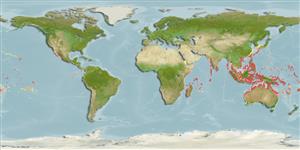>
Eupercaria/misc (Various families in series Eupercaria) >
Scaridae (Parrotfishes) > Scarinae
Etymology: Scarus: Greek, skaros = a fish described by anciente writers as a parrot fish; 1601 (Ref. 45335).
More on author: Bleeker.
Environment: milieu / Klimaatzone / Diepte / distribution range
Ecologie
marien rifbewoner; diepte 2 - 25 m (Ref. 37816). Tropical
Indo-Pacific: widespread in the Indian Ocean (Ref. 9793), ranging from East Africa south to Natal, South Africa (Ref. 5490) and east to Madagascar, Seychelles, Mauritius, Chagos Archipelago, and Maldives through the eastern Indian Ocean to French Polynesia and Pitcairn. Replaced by Scarus forsteni in most of the Pacific, with overlapping distributions in the Philippines, eastern Indonesia and Palau (Ref. 37816). Recently reported from Tonga (Ref. 53797).
Grootte / Gewicht / Leeftijd
Maturiteit: Lm ? range ? - ? cm
Max length : 52.7 cm TL mannelijk / geslacht onbekend; (Ref. 125599); common length : 17.5 cm SL mannelijk / geslacht onbekend; (Ref. 9793); max. gepubliceerd gewicht: 2.9 kg (Ref. 125599)
Korte beschrijving
Determinatiesleutels | Morfologie | Morfometrie
Dorsale stekels (totaal) : 9; Dorsale zachte stralen (totaal) : 10; Anale stekels: 3; Anale zachte stralen: 9. Males differ slightly in head pattern and differences most obvious in females with yellow or red anal fins (Ref. 48636). Terminal phase similar to S. forsteni, differing primarily by having a yellow inner pectoral axil (Ref. 37816).
Body shape (shape guide): fusiform / normal.
Inhabits lagoon and seaward reefs, in areas with dense coral growth (Ref. 9710) up to at least 30 m. Usually solitary, sometimes in groups (Ref. 9710). Feeds on benthic algae (Ref. 3488).
Levenscyclus en paargedrag
Maturiteit | Voortplanting | Paaien | Eieren | Fecunditeit | Larven
Oviparous, distinct pairing during breeding (Ref. 205).
Randall, J.E. and J.H. Choat, 1980. Two new parrotfishes of the genus Scarus from the Central and South Pacific, with further examples of sexual dichromatism. Zool. J. Linn. Soc. 70:383-419. (Ref. 2689)
Status op de Rode Lijst van het IUCN (Ref. 130435: Version 2025-1)
Gevaar voor de mens
Harmless
Gebruik door de mens
Visserij: commercieel; Aquarium: Commercieel
Tools
Speciale rapporten
Download XML
Internetbronnen
Estimates based on models
Preferred temperature (Ref.
123201): 24.9 - 29.3, mean 28.4 °C (based on 3096 cells).
Fylogenetische diversiteitsindex (Ref.
82804): PD
50 = 0.5000 [Uniqueness, from 0.5 = low to 2.0 = high].
Bayesian length-weight: a=0.01778 (0.01087 - 0.02908), b=3.06 (2.93 - 3.19), in cm total length, based on LWR estimates for this species & Genus-body shape (Ref.
93245).
Trofisch niveau (Ref.
69278): 2.0 ±0.0 se; based on diet studies.
Weerstandsvermogen (Ref.
120179): Gemiddeld, minimale populatieverdubbelingstijd 1,4-4,4 jaar (Preliminary K or Fecundity.).
Fishing Vulnerability (Ref.
59153): Moderate vulnerability (41 of 100).
🛈
Nutrients (Ref.
124155): Calcium = 51.9 [33.6, 86.3] mg/100g; Iron = 0.833 [0.578, 1.274] mg/100g; Protein = 18.5 [16.5, 20.3] %; Omega3 = 0.094 [0.064, 0.138] g/100g; Selenium = 16.9 [10.4, 26.6] μg/100g; VitaminA = 59.4 [18.4, 194.3] μg/100g; Zinc = 2.51 [1.91, 3.27] mg/100g (wet weight); based on
nutrient studies.
